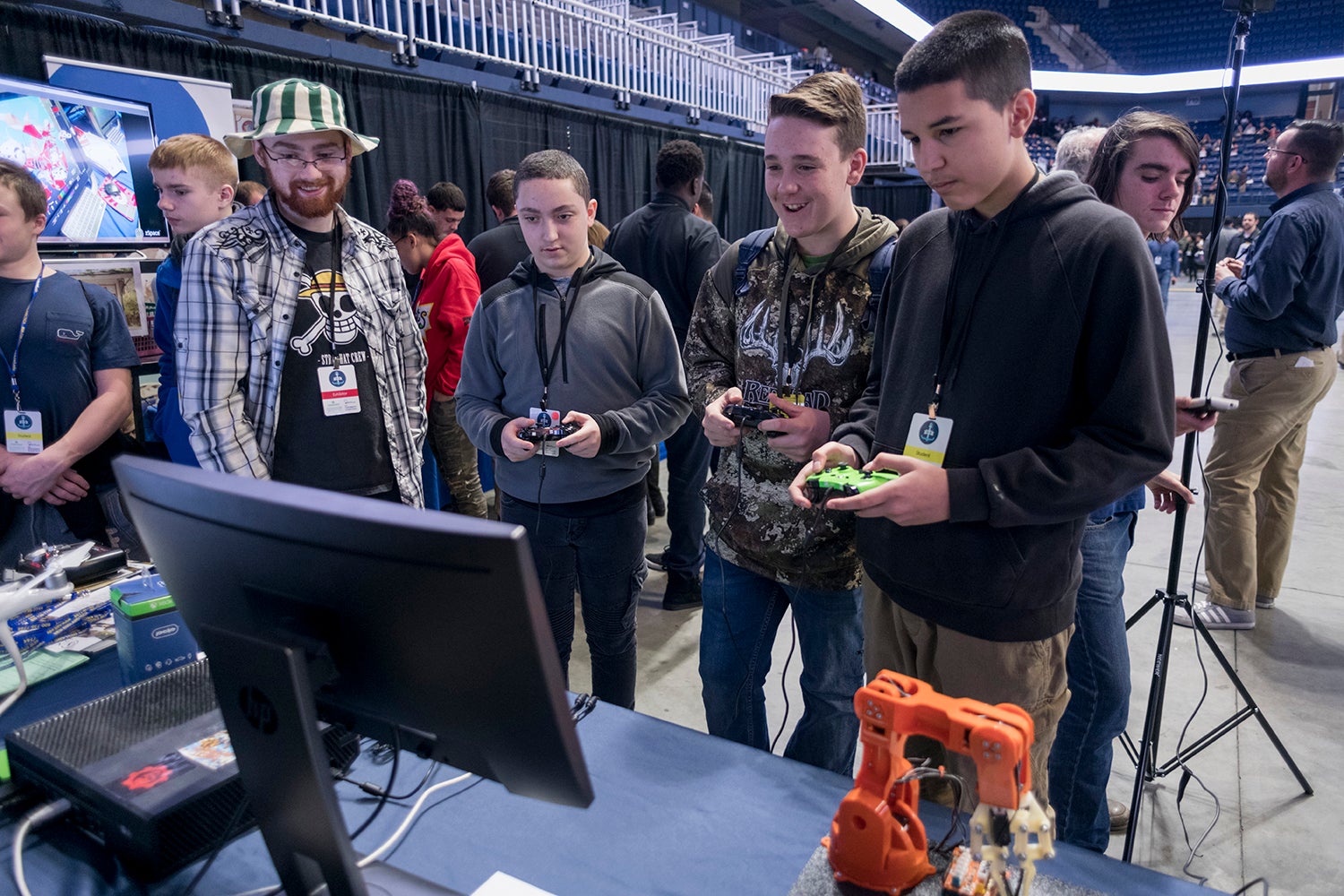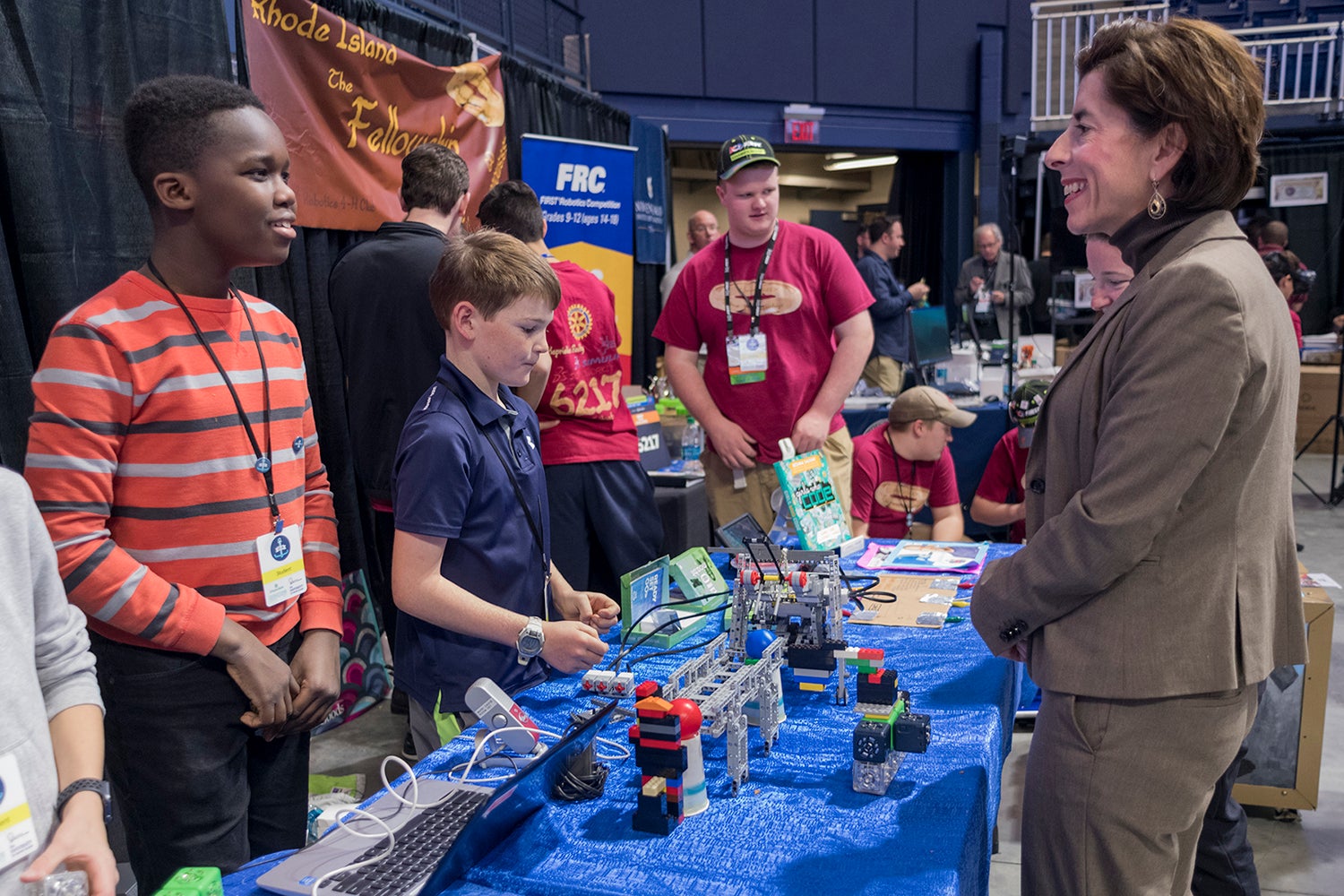KINGSTON, R.I. – December 13, 2017 — An undersea torpedo, a drone, augmented reality glasses, video games, apps and robots were all on display on the floor of the Ryan Center at the University of Rhode Island on Wednesday as students, business leaders and educators from across the state met at the second Computer Science 4 Rhode Island Summit, hosted by Gov. Gina Raimondo.
The event celebrated the advancements of Raimondo’s CS4RI Initiative, launched in 2016 as one of the most comprehensive computer science initiatives in the country. The initiative aims to increase students’ exposure to computer science skills and to increase access to computer science education to all communities of Rhode Island.
“I spoke with a young woman from Barrington earlier who said, ‘I never knew computer science could be so much fun,’ ” Raimondo said. “And she wasn’t taking a computer science class, she was taking a business class. It’s about integrating these kinds of skills into the curriculum.”

The summit brought together middle school, high school and college students, industry professionals, training providers and community members to showcase projects, research, education and career opportunities related to computer science and technology. Exhibitors included representatives from business and industry — such as Citizens Bank, FM Global, CVS Health, Accenture, Amica, and many more — as well as colleges, universities and K-12 schools.
Raimondo said there are 1,300 computer science jobs in the state of Rhode Island, yet only 800 students graduated from colleges and universities across the state with degrees in computer science last year. She implored students to set a goal to help double that number by the year 2025, when many of them will graduate from an institution of higher learning.
“If there are 1,300 computer science jobs here in the state, we want them to be filled by workers coming from our schools,” she said. “We’re recruiting these companies here to Rhode Island to give you a chance for a good future in our state. We want to give everyone a chance.”
One of the primary goals of Raimondo’s Office of Innovation is to increase the access students at all schools in Rhode Island have to computer science education. She said that when the Office of Innovation was created last year, only 42 students in Rhode Island participated in Advanced Placement computer science tests. Only 14 of them were girls and none were people of color. In 2017, however, 265 students took the tests, a 630 percent increase.
“I think the next Mark Zuckerberg is probably going to be a woman, probably someone of color,” Raimondo said. “That person could be here in this room, a student from Tolman, Barrington, Scituate, Classical, or any of the other schools across our state. But we have to make sure that you have access to those classes to give you an opportunity to realize your potential.”
Giving students access to those kinds of courses is the focus of the national non-profit group Girls Who Code, an organization dedicated to closing the gender gap in technology. Leah Gilliam, vice president of education, strategy and innovation at the company, said giving students that access to education is crucial to their success, particularly among women and minorities.
She stressed the need for diverse viewpoints in the computer science fields, noting that technologies inherently have the biases of their creators baked into them. For example, the airbag was created in the 1980s, designed by men and it saved many thousands of lives. However, in 2003, a group of Swedish engineers began to study the efficacy of airbags and noticed that all crash test dummies basically resembled average sized males. They determined that testing the true efficacy of airbags was impossible without accounting for different body sizes and types, to study how they move during an accident.
She also noted that the performance of voice-activated technologies suffers when used by consumers with strong accents or people who speak English as a second language. Those kinds of inherent biases can be mitigated with a more diverse workforce, she said.
Given the ever-expanding role of technology in our daily lives, she said the students at the summit are at an advantage over earlier generations of workers.
“You guys are learning now what I was learning in grad school 10 years ago,” she said. “Computer science is the new reading. You need to know how to do it to do anything. “
Barbara Cottam, chair of the Rhode Island Board of Education and an executive vice president at Citizens Bank, pointed out that opportunity abounds for careers in computer science, with 486,000 jobs nationally, and only 43,000 computer science degrees awarded by colleges and universities across the country in 2016.
She said the Rhode Island education system has poured resources into giving students access to computer science courses, training 500 teachers over the past year and half, and creating the STEM Pathway Endorsement, an achievement that students can gain to go along with their diploma by successfully completing certain coursework.
Lily O’Connor, 15, of Portsmouth, and Ethan Nappi, 16, of Tiverton, are among the students who have benefited from Rhode Island’s increased commitment to computer science education. The pair are part of a robotics team from The Met East Bay School, part of a network of six small, public high schools located in Providence and Newport.
O’Connor and Nappi designed and coded a wheeled robot that can pick up cubes and deposit them in a receptacle. The project was part of the First Tech Challenge, a Mentor-based program that builds science, engineering, and technology skills.
Though they were working on a tight timeline, O’Connor and Nappi managed to achieve their goal and they have now set about the task of coding the robot to drive itself and return to a parked position.
For O’Connor, her interest in robots and computer coding was handed down at an early age from her parents – her father is a computer scientist and her mother is a mechanical engineer.
“I’ve always loved taking things apart and figuring out how they worked,” she said. “Three years ago, I joined a robotics team and started to learn coding and my dad gave me an old javascript textbook of his, so I’ve been doing it ever since.”
For Nappi, his desire to pursue coding came from his enjoyment of video games.
“As long as I can remember, I’ve always loved playing video games, but a year ago I decided to start making them,” he said. “I started to learn coding and then I joined the robotics team and it’s really cool.”

